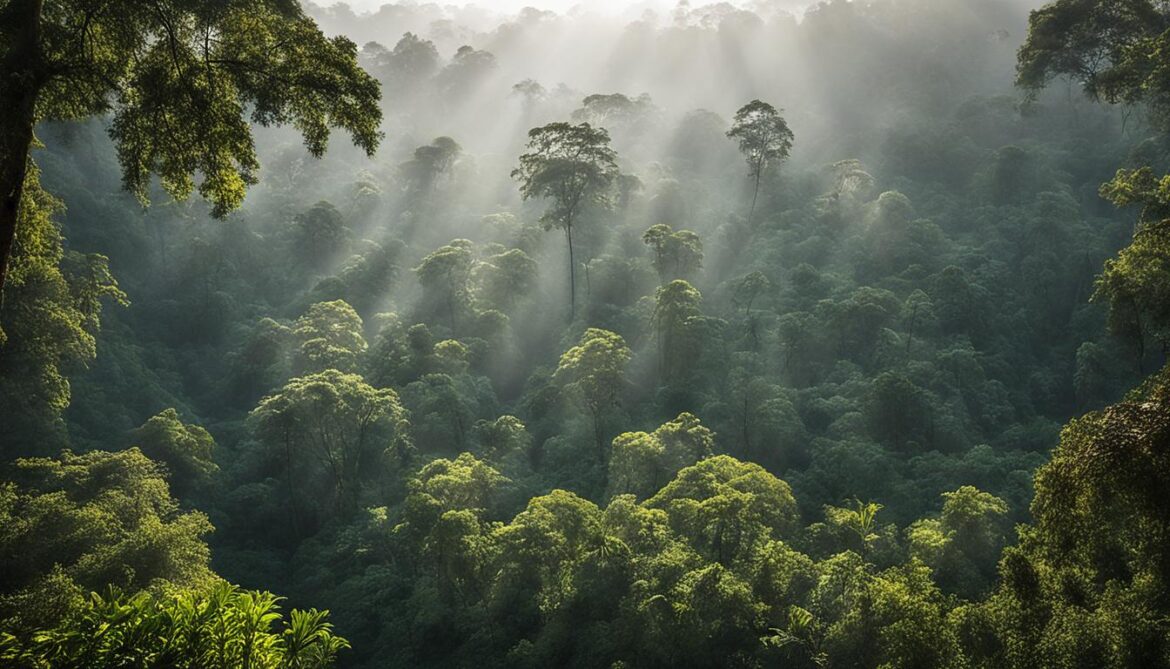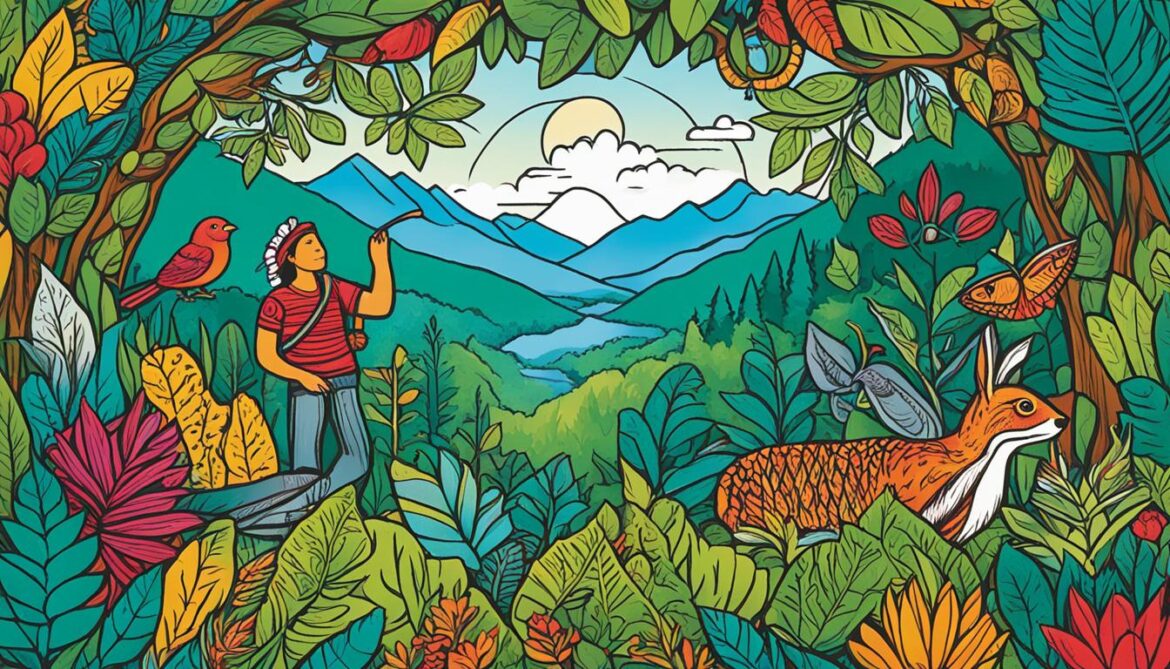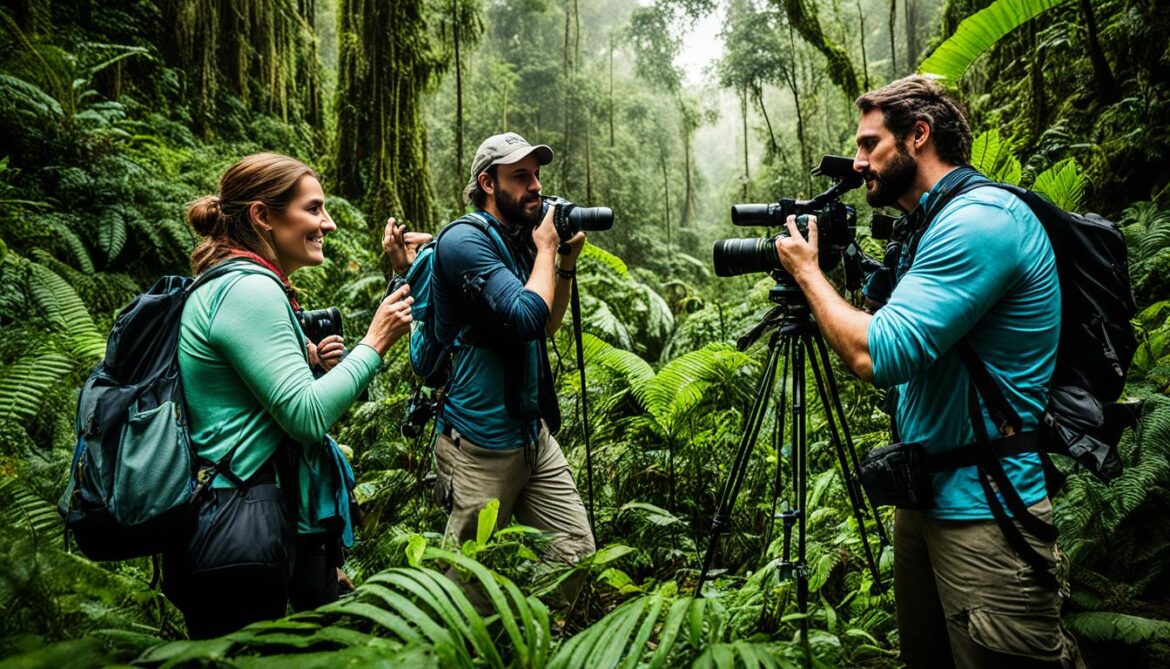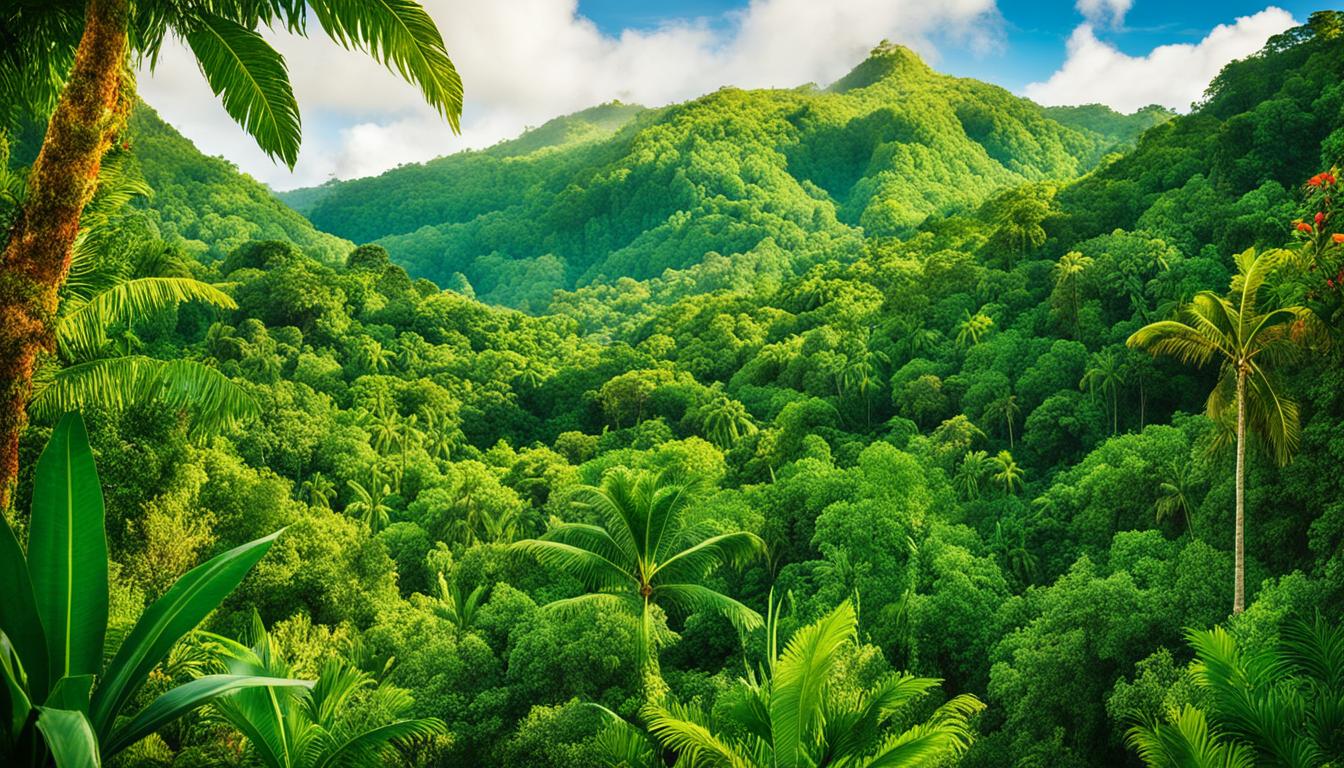Guatemala Sacred Natural Sites and Biodiversity
Did you know that Guatemala’s sacred forests cover a significant portion of the country’s territory and are home to a rich array of endangered species? The northwest region of the country boasts stunning landscapes that are not only biologically diverse but also hold deep cultural and spiritual significance.
Key Takeaways:
- Guatemala’s sacred forests are a vital part of the country’s natural heritage and are rich in biodiversity.
- Efforts are being made to recognize and incorporate the cultural and spiritual values of these forests into sustainable forest management practices.
- Collaboration between the Sacred Natural Sites Initiative and Oxlajuj Ajpop is empowering communities to manage and protect their sacred forests and natural resources.
- Sacred Natural Sites play a crucial role in biodiversity conservation by providing sanctuaries for endangered species and contributing to the preservation of biocultural diversity.
- An international workshop on the importance of sacred natural sites highlighted the traditional mechanisms of environmental conservation in different regions.
The Collaboration between SNSI and Oxlajuj Ajpop
The collaboration between the Sacred Natural Sites Initiative (SNSI) and Oxlajuj Ajpop, the National Council of Mayan Spiritual Leaders, aims to enhance sustainable cultural and community forest management practices in sacred forests in Guatemala. Working closely with rural communities in the Quiche district, this collaboration involves the development of indicators, principles, and recommendations for the forestry sector and other stakeholders. The goal is to integrate cultural, spiritual, and community values into sustainable forest management practices.
Oxlajuj Ajpop, representing the Mayan spiritual leaders, plays a vital role in guiding the development of community action plans and protocols for the safekeeping of sacred places and forests. These plans and protocols ensure that cultural and spiritual aspects are considered in the management of natural resources. They also serve as a platform for dialogues with various stakeholders, fostering collaboration and understanding between communities and the sustainable forestry sector.
The collaboration between SNSI and Oxlajuj Ajpop signifies a significant step towards the integration of cultural and community forest management into the sustainable forestry sector. By recognizing and valuing the cultural and spiritual importance of sacred forests, this collaboration promotes a holistic approach to natural resource management, fostering the long-term preservation of Guatemala’s natural heritage.
Community Action Plans and Forest Value Indicators
One of the key outcomes of the collaboration between SNSI and Oxlajuj Ajpop is the development of community action plans for forest management. These plans are designed to empower local communities to take ownership of their sacred forests and implement sustainable practices. They provide a framework for community-led initiatives, ensuring that the cultural, spiritual, and community values associated with these forests are upheld.
Forest value indicators are also being developed to effectively communicate the cultural and spiritual significance of sacred forests to forest stakeholders. These indicators serve as a tool for sustainable forestry practices, facilitating a better understanding of the multiple values and benefits that these forests provide. By incorporating cultural and spiritual values into forest management, the collaboration aims to create a more comprehensive and inclusive approach to natural resource management.
“The collaboration between SNSI and Oxlajuj Ajpop is a testament to the importance of recognizing and integrating cultural and community values into sustainable forest management practices.”
Through the development of community action plans and forest value indicators, the collaboration between SNSI and Oxlajuj Ajpop is making significant strides towards incorporating cultural and community forest management into the sustainable forestry sector. By amplifying the voices of local communities and Mayan spiritual leaders, this collaboration aims to create a harmonious balance between environmental conservation and cultural preservation in Guatemala’s sacred forests.
Collaborative Dialogues and Recommendations
Collaborative dialogues play a crucial role in the ongoing collaboration between SNSI and Oxlajuj Ajpop. These dialogues provide a platform for open discussions and knowledge sharing between Mayan spiritual leaders, local communities, and forest stakeholders. By fostering dialogue, the collaboration seeks to bridge the gap between traditional knowledge and scientific approaches, creating a more holistic and sustainable forest management system.
As a result of these dialogues, the collaboration has generated valuable recommendations for the forestry sector and other stakeholders. These recommendations draw upon the cultural and spiritual insights of Mayan spiritual leaders and the experiences of local communities. By integrating these recommendations into forest management practices, the collaboration aims to promote a more inclusive and equitable approach to natural resource management.
- Development of community action plans for sustainable forest management.
- Creation of forest value indicators to communicate cultural and spiritual significance.
- Facilitation of collaborative dialogues between Mayan spiritual leaders and forest stakeholders.
- Generation of recommendations for sustainable forest management practices.
The collaborative dialogues and recommendations serve as the building blocks for a more comprehensive and culturally sensitive approach to forest management. By engaging all stakeholders in the decision-making process, the collaboration aims to create a sustainable forestry sector that respects and upholds the cultural and spiritual values of sacred forests in Guatemala.
Guatemala’s Forests and Biodiversity
The sub-tropical and cloud forests in Guatemala are renowned for their incredible biodiversity and play a vital role in the country’s natural landscape. These forests, found predominantly in the northwest region, cover a significant portion of Guatemala’s national territory, boasting steeped mountains and lush vegetation. They are an integral part of the Biological Mesoamerican Corridor, which is considered the largest remaining tropical lowland forest and wetland in Central America.
Guatemala’s diverse forests are home to a wide range of plant and wildlife species, including several endangered species. The abundant biodiversity found in the sub-tropical and cloud forests contributes to the region’s ecological resilience and conservation efforts. It serves as a sanctuary for many rare and endangered species, acting as gene pools for restoring degraded environments.

Within these forests, the rich biodiversity creates a delicate balance of ecosystems, providing habitats for numerous endemic species. The presence of unique flora and fauna highlights the importance of preserving and protecting these sub-tropical and cloud forests in Guatemala for future generations.
| Key Points | Benefits |
|---|---|
| Biodiversity in Guatemala’s forests | Supports a wide range of plant and wildlife species |
| Endangered species | Provides a habitat for several endangered species |
| Sub-tropical and cloud forests | Contribute to ecological resilience |
| Biological Mesoamerican Corridor | Largest remaining tropical lowland forest and wetland in Central America |
Protecting and conserving the forests and their biodiversity is crucial to maintaining the overall ecological balance of the region. The preservation of these natural habitats not only ensures the survival of endangered species but also contributes to the cultural identity and heritage of Guatemala.
Recognition of Cultural Values in Sustainable Forest Management
In Guatemala, sustainable forest management practices acknowledge the importance of cultural values, including the preservation of sacred forests. The International Tropical Timber Organization (ITTO) has established criteria and indicators that incorporate the cultural and spiritual values of protected areas, ensuring their conservation within sustainable forestry endeavors.
However, there is a growing need to broaden the recognition of cultural values and develop a comprehensive understanding of the significance of forests in Guatemala. The International Union for Conservation of Nature (IUCN) Specialist Group on Cultural and Spiritual Values of Protected Areas has recommended to the United Nations Forum on Forests (UNFF) the safeguarding of cultural, sacred, and religious forests. These recommendations emphasize the integration of cultural values into forest management practices to ensure the holistic protection of Guatemala’s natural heritage.
“Recognizing and valuing the cultural and spiritual significance of forests is essential in promoting sustainable forest management that encompasses the diverse needs and aspirations of local communities.”
By embracing cultural values within sustainable forest management, Guatemala can create a harmonious balance between ecological conservation and the preservation of its rich cultural and spiritual traditions.
The ITTO Criteria for Sustainable Forest Management
| Criterion | Description |
|---|---|
| 1. Biodiversity Conservation | Preservation of forest ecosystems to support biodiversity and protect endangered species. |
| 2. Forest Health and Vitality | Management practices that maintain the resilience and vitality of forest ecosystems. |
| 3. Productive Functions and Forest Resources | Sustainable use of forest resources to fulfill ecological, economic, and social needs. |
| 4. Biological Productivity and Processes | Ensuring the regeneration and productivity of forest ecosystems. |
| 5. Protective Functions | Forest management practices that mitigate environmental risks and preserve natural functions. |
| 6. Soil and Water Conservation | Preserving soil integrity and water resources through sustainable forest practices. |
| 7. Socio-Economic Functions and Conditions | Addressing the socio-economic needs and aspirations of local communities. |
| 8. Legal, Institutional, and Economic Framework | Ensuring that forest management adheres to legal and institutional frameworks. |
The ITTO Criteria for Sustainable Forest Management encapsulate the importance of both ecological stewardship and cultural values, providing a holistic approach to forest conservation in Guatemala. By aligning these criteria with the cultural and spiritual values of protected areas, sustainable forest management can be truly inclusive and effective.
Sources:
- ITTO Criteria and Indicators for Sustainable Forest Management – https://www.itto.int/sfm
- IUCN Specialist Group on Cultural and Spiritual Values of Protected Areas – https://www.iucn.org/commissions/world-commission-protected-areas/about/what-we-do/biodiv-2014-beyond-care-web-site/protected-areas-programme-work/practising-protected-areas-principle-3-sepp-1-and-2

Community Action for Forest and NRM Management
In the Quiche district, communities are actively involved in community-based forest and natural resource management, working in partnership with Oxlajuj Ajpop and the Sacred Natural Sites Initiative (SNSI). These communities have taken the initiative to develop their own community action plans to ensure sustainable forest and NRM management. With a deep understanding of the cultural and spiritual importance of their sacred places and forests, they have also created community protocols to safeguard these precious resources.
One of the key challenges faced is effectively communicating the value of these forests to forest stakeholders. To address this, forest value indicators are being developed by the communities. These indicators will help showcase the cultural, sacred, and spiritual significance of the forests, providing a comprehensive understanding to stakeholders who may not be directly aware of their importance.
Dialogues and Collaboration
Another important aspect of community action for forest and NRM management is the facilitation of dialogues between communities and forest-related stakeholders. These dialogues allow for meaningful conversations, fostering mutual understanding and collaboration towards sustainable forest management practices. By engaging in open and inclusive dialogues, communities can share their knowledge, experiences, and concerns, while stakeholders can provide valuable insights and support.
Additionally, education materials on forests and natural resource management are being developed for schools to raise awareness and foster environmental stewardship among younger generations. These educational materials aim to inspire students to appreciate the value of forests, nurturing a sense of responsibility towards their preservation and long-term sustainable management.
To further amplify the reach and impact of community efforts, participatory videos are being produced. These videos document the experiences and knowledge of the communities engaged in forest and natural resource management. By sharing these videos with other communities and forest stakeholders, valuable insights can be exchanged, empowering more individuals and groups to adopt community-based practices for sustainable forest and NRM management.

| Community Action for Forest and NRM Management | Key Initiatives |
|---|---|
| Community Action Plans | Developing community action plans for sustainable forest and NRM management |
| Community Protocols | Creating protocols for the safekeeping of sacred places and forests |
| Forest Value Indicators | Developing indicators to communicate the cultural and spiritual importance of forests |
| Dialogues and Collaboration | Facilitating dialogues between communities and forest stakeholders for mutual understanding and collaboration |
| Education Materials | Creating educational resources on forests and NRM for schools |
| Participatory Videos | Producing videos to share experiences and knowledge with other communities and stakeholders |
Success of Oxlajuj Ajpop in Indigenous Values
In Guatemala, Oxlajuj Ajpop, the National Council of Mayan Spiritual Leaders, has been successful in creating change based on indigenous values. As part of the International COMPAS Network, Oxlajuj Ajpop has worked with numerous communities for over 14 years, focusing on improving their well-being and promoting stewardship of the environment.
Oxlajuj Ajpop has developed a Social-Environmental Agenda and has also been involved in the development of a proposal for a law on the Indigenous management of Sacred Sites in Guatemala. The organization seeks to integrate indigenous knowledge and values into environmental conservation and management efforts.
“Our mission is to honor and protect our sacred sites, which are the living link between humans and nature. Through our collaboration with communities, we aim to foster a deep connection with the land and promote sustainable practices in harmony with the natural world.” – Mayan spiritual leader, Oxlajuj Ajpop
Through their work, Oxlajuj Ajpop empowers indigenous communities to reclaim their cultural heritage and play an active role in shaping the future of their land. By recognizing the importance of indigenous values in environmental conservation, they pave the way for a more holistic and inclusive approach to sustainable development.
With their commitment to indigenous values, Oxlajuj Ajpop serves as a guiding light in the movement towards a harmonious coexistence between humans and nature, preserving Guatemala’s unique cultural and ecological heritage for generations to come.

| Key Achievements of Oxlajuj Ajpop | Impact |
|---|---|
| Development of the Social-Environmental Agenda | Guides initiatives for sustainable development rooted in indigenous values. |
| Proposal for a law on Indigenous management of Sacred Sites in Guatemala | Fosters recognition and protection of sacred sites, preserving cultural and spiritual heritage. |
| Collaboration with communities for over 14 years | Empowers indigenous communities to reclaim their cultural heritage and promote sustainable practices. |
| Integration of indigenous knowledge and values | Shapes environmental conservation and management efforts in a holistic and inclusive manner. |
Importance of Sacred Natural Sites for Biodiversity Conservation
Sacred Natural Sites play a crucial role in the conservation of biodiversity and the promotion of biocultural diversity. These sacred sites are often characterized by near-natural ecosystems that have withstood environmental degradation due to their cultural and spiritual significance. They provide essential sanctuaries for rare and endangered species, acting as vital gene pools for restoring degraded environments.
In the words of renowned biologist Dr. Jane Goodall, “Sacred Natural Sites are like living museums, where rare and endangered species find refuge, and important genetic diversity is preserved for the future.”
These sites not only serve as biodiversity hotspots but also hold immense cultural value. They are important reference places of cultural identity, strengthening the connection between communities and their natural environments. By protecting and preserving these sacred sites, we contribute to the conservation of both biological and cultural heritage.

Through their cultural and spiritual significance, Sacred Natural Sites inspire reverence and respect for nature, promoting sustainable practices and responsible stewardship. They offer a tangible experience of the interdependence between humans and the natural world, reminding us of the need to maintain harmony with our environment.
The conservation of Sacred Natural Sites not only safeguards rare and endangered species but also contributes to the overall health and resilience of ecosystems. The preservation of these sites can enhance the connectivity of habitats, allowing for the free movement of wildlife and promoting the ecological balance necessary for the well-being of our planet.
As we strive to protect and restore biodiversity, it is essential to recognize the intrinsic value of Sacred Natural Sites and acknowledge the vital role they play in both ecological and cultural contexts. By embracing their significance and integrating traditional knowledge and values into conservation efforts, we pave the way for a harmonious coexistence between humans and the natural world, ensuring a sustainable future for generations to come.
International Workshop on the Importance of Sacred Natural Sites
An international workshop on the Importance of Sacred Natural Sites for Biodiversity Conservation was recently held in Kunming and Xishuangbanna Biosphere Reserve, People’s Republic of China. The workshop, organized by UNESCO in collaboration with the Chinese Academy of Sciences, IUCN, the Man and the Biosphere Programme, and WWF-Mexico Programme, aimed to promote awareness and understanding of the relationships between sacred natural sites and biodiversity conservation.
“The workshop provided a unique platform for experts, researchers, and practitioners from across the globe to come together and share insights on the significance of sacred natural sites in conserving biodiversity,” said Dr. Maria Lopez, a leading expert on conservation biology.
During the workshop, case studies from Africa, Asia-Pacific, and Latin America were presented, showcasing traditional mechanisms of environmental conservation in different regional contexts. Experts emphasized the need to recognize the cultural, spiritual, and community values associated with sacred natural sites and integrate them into conservation strategies.
Key Outcomes of the Workshop:
- Greater recognition of the importance of sacred natural sites in biodiversity conservation.
- Enhanced understanding of the cultural and spiritual significance of these sites.
- Identification of best practices for integrating sacred natural sites into conservation policies and programs.
- Strengthened collaboration between stakeholders, including UNESCO, IUCN, and the Chinese Academy of Sciences.
The workshop concluded with a call to action for governments, policymakers, and conservation organizations to prioritize the protection and management of sacred natural sites as a crucial aspect of biodiversity conservation efforts.
| Date | Location | Organizers |
|---|---|---|
| March 15-17, 20XX | Kunming and Xishuangbanna Biosphere Reserve, People’s Republic of China | UNESCO, Chinese Academy of Sciences, IUCN, Man and the Biosphere Programme, WWF-Mexico Programme |

The International Workshop on the Importance of Sacred Natural Sites for Biodiversity Conservation brought together experts and practitioners to foster a deeper understanding of the crucial role played by these sites in preserving biodiversity. By recognizing their cultural, spiritual, and ecological significance, we can work towards a more holistic approach to conservation that respects and celebrates the connections between people and nature.
Conclusion
The intertwining of spirituality and nature in Guatemala’s Sacred Natural Sites is a powerful force for biodiversity conservation. Through collaboration between organizations like the Sacred Natural Sites Initiative and Oxlajuj Ajpop, communities are empowered to manage and protect their sacred forests and natural resources. The recognition of cultural values in sustainable forest management practices is crucial for the preservation of Guatemala’s natural heritage. By valuing the sacred landscapes and wildlife sanctuaries, Guatemala can ensure the conservation of its rich biodiversity for future generations.








